

Czech Republic Travel Notes. Short URL: - National Anthem of Czech Republic.
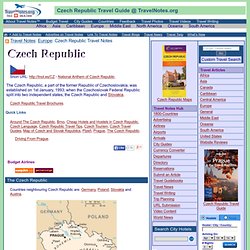
The Czech Republic, a part of the former Republic of Czechoslovakia, was established on 1st January, 1993; when the Czechoslovak Federal Republic split into two independent states, the Czech Republic and Slovakia. Czech Republic Travel Brochures. Quick Links Around The Czech Republic, Brno, Cheap Hotels and Hostels in Czech Republic, Czech Language, Czech Republic Travel Tips, Czech Tourism, Czech Travel Guides, Map of Czech and Slovak Republics, Plzeñ, Prague, The Czech Republic. Driving From Prague. Budget Airlines Countries neighbouring Czech Republic are: Germany, Poland, Slovakia and Austria.
Czech Republic. The Czech Republic ( i/ˈtʃɛk rɨˈpʌblɪk/ CHEK RƏPUBLIK;[10] Czech: Česká republika, pronounced [ˈt͡ʃɛskaː ˈrɛpuˌblɪka] ( ), short form Česko Czech pronunciation: [ˈt͡ʃɛsko]) is a landlocked country in Central Europe.
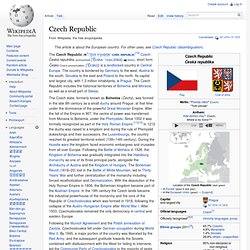
The country is bordered by Germany to the west, Austria to the south, Slovakia to the east and Poland to the north. Its capital and largest city, with 1.3 million inhabitants, is Prague. History of Czechoslovakia. With the collapse of the Habsburg monarchy at the end of World War I, the independent country of Czechoslovakia[1] (Czech, Slovak: Československo) was formed, encouraged by, among others, U.S.

President Woodrow Wilson. The Czechs and Slovaks were not at the same level of economic and technological development, but the freedom and opportunity found in an independent Czechoslovakia enabled them to make strides toward overcoming these inequalities. However, the gap between cultures was never fully bridged, and the discrepancy played a continuing role throughout the seventy-five years of the union. Political history[edit] Historical settings to 1918[edit] Czechoslovak Legions in Vladivostok (1918)
Prague. The Prague Astronomical Clock was first installed in 1410, making it the third-oldest astronomical clock in the world and the oldest one still working.
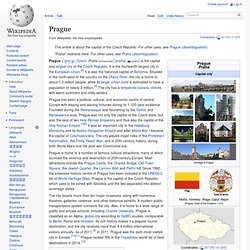
Duchy of Bohemia. The Duchy of Bohemia was formerly part of Great Moravia and became an independent principality in the 9th century.
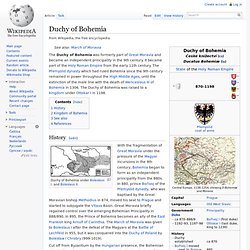
It became part of the Holy Roman Empire from the early 11th century. The Přemyslid dynasty which had ruled Bohemia since the 9th century remained in power throughout the High Middle Ages, until the extinction of the male line with the death of Wenceslaus III of Bohemia in 1306. The Duchy of Bohemia was raised to a kingdom under Ottokar I in 1198. Defenestrations of Prague. The Defenestrations of Prague (Czech: Pražská defenestrace, German: Prager Fenstersturz) were two incidents in the history of Bohemia; there have been more, see below.
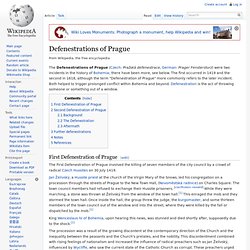
The first occurred in 1419 and the second in 1618, although the term "Defenestration of Prague" more commonly refers to the later incident. Both helped to trigger prolonged conflict within Bohemia and beyond. Defenestration is the act of throwing someone or something out of a window. Charles IV, Holy Roman Emperor. Charles IV (Czech: Karel IV., German: Karl IV., Latin: Carolus IV; 14 May 1316 – 29 November 1378[1]), born Wenceslaus,[2] was the second King of Bohemia from the House of Luxembourg, and the first King of Bohemia also to become Holy Roman Emperor.
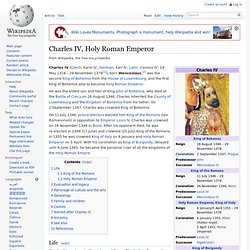
He was the eldest son and heir of King John of Bohemia, who died at the Battle of Crécy on 26 August 1346. Charles inherited the County of Luxembourg and the Kingdom of Bohemia from his father. On 2 September 1347, Charles was crowned King of Bohemia. On 11 July 1346, prince-electors elected him King of the Romans (rex Romanorum) in opposition to Emperor Louis IV. Charles was crowned on 26 November 1346 in Bonn. Life[edit] Emperor Charles IV elected Greatest Czech of all time. Charles IV, the 14th-century Holy Roman emperor and King of Bohemia has been making headlines lately.
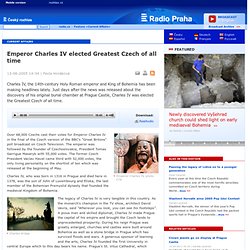
Hussite Wars. Czechoslovakia. Czechoslovakia (or Czecho-Slovakia;[1] Czech and Slovak: Československo, Česko-Slovensko)[2] was a sovereign state in Central Europe that existed from October 1918, when it declared its independence from the Austro-Hungarian Empire, until its peaceful dissolution into Czechia and Slovakia on 1 January 1993.
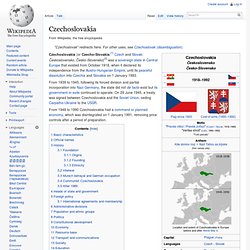
From 1939 to 1945, following its forced division and partial incorporation into Nazi Germany, the state did not de facto exist but its government-in-exile continued to operate. On 29 June 1945, a treaty was signed between Czechoslovakia and the Soviet Union, ceding Carpatho-Ukraine to the USSR. From 1948 to 1990 Czechoslovakia had a command or planned economy, which was disintegrated on 1 January 1991, removing price controls after a period of preparation.
Basic characteristics[edit] Velvet Revolution. Memorial plaque on Albertov (cs), the place where Velvet revolution started.
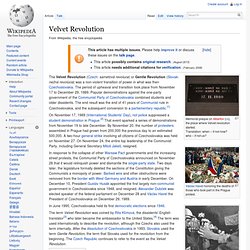
Translation: when – if not now? Who – if not us? Václav Havel honoring the deaths of those who took part in the Prague protest. Non-violent protesters facing armed policemen with flowers The Velvet Revolution (Czech: sametová revoluce) or Gentle Revolution (Slovak: nežná revolúcia) was a non-violent transition of power in what was then Czechoslovakia. On November 17, 1989 (International Students' Day), riot police suppressed a student demonstration in Prague.[2] That event sparked a series of demonstrations from November 19 to late December.
The Good Soldier Švejk. The Good Soldier Švejk (/ˈʃveɪk/; Czech: [ˈʃvɛjk]), also spelled Schweik or Schwejk, is the abbreviated title of an unfinished satirical/dark comedy novel by Jaroslav Hašek. Czech Republic - Czech Republic - Villa Tugendhat. Functionalism in Villa Tugendhat Villa Tugendhat has borne witness to the birth of modern housing and also to the tragic fate of the people who lived there. This work by the famous German architect Mies van der Rohe is to this very day regarded as one of the four most important villas in the world. Thanks to its values, this gem of modern architecture has also been included in the UNESCO world heritage list. Villa Tugendhat in the Brno city district of Černá Pole was built at the request of Greta and Fritz Tugendhat who came from a rich textile trading family in Brno. Jewish Museum in Prague. Theresienstadt concentration camp. Coordinates : 50°30′48″N 14°10′1″E / 50.51333°N 14.16694°E / 50.51333; 14.16694 The (2005) , also referred to as Theresienstadt Ghetto, [ 1 ] [ 2 ] [ 3 ] was established by the SS during World War II in the fortress and garrison city of Terezín (German name ), located in what is now the Czech Republic.
During World War II it served as a Nazi concentration camp staffed in equal numbers by German Nazi guards and their ethnic Czech collaborators. Tens of thousands of Jews were murdered there and over 150,000 others (including tens of thousands of children) were held there for months or years, before then being sent to their deaths on rail transports to Treblinka and Auschwitz extermination camps in Poland, as well as to smaller camps elsewhere. [ edit ] History. The History of the Czech Republic and Slovakia - William Mahoney. Rick Steves' Prague and the Czech Republic - Rick Steves, Honza Vihan. History of Czech Republic.